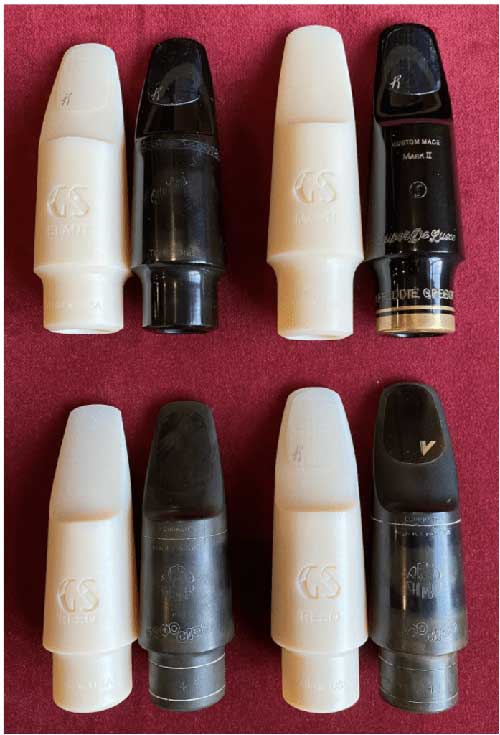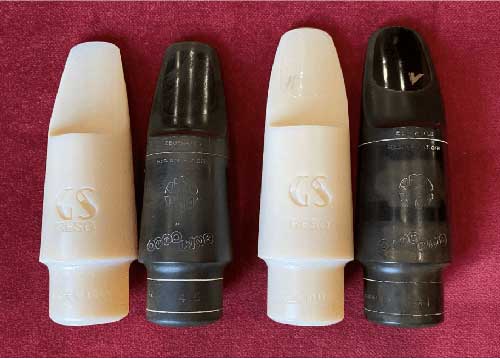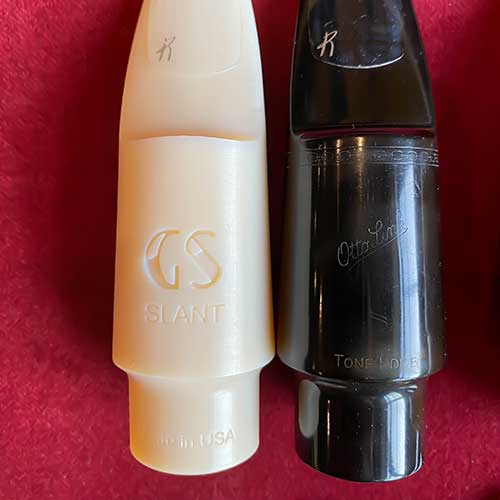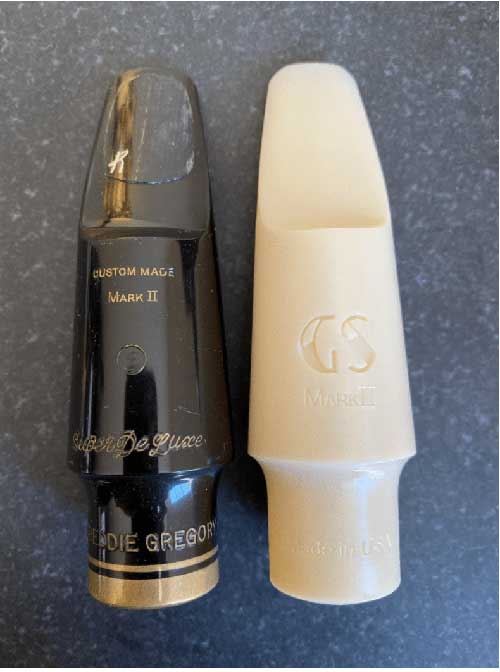GS Mouthpieces: Do These Replicas Compare To The Real Thing?

Introduction
Since reviewing saxophone gear for quite some time, I have had the opportunity to play test quite a few vintage Meyers, Links, Dukoff’s, Brilhart’s, Guardala’s as well as the “new” vintage copies or close replicas of these sought after mouthpieces. Now, for many of us the idea of spending between $500-$2,000+ on a vintage mouthpiece that many times will need some refacing work is a bit challenging to wrap our heads around but others have found great success. There are quite a few manufacturers that are offering “copies” of these sought after vintage pieces but many times, if you have had a chance or actually own an original, they unfortunately fall short for various reasons. With that being said, this doesn’t mean these mouthpieces are not good alternatives but they are not necessarily true copies of the original vintage pieces.
Recently, I have heard quite a bit of news regarding a few mouthpiece brands but one in particular that caught my eye was GS Mouthpieces by GetASax. GetASax.com carries a wide assortment of vintage & modern saxophones, mouthpieces, ligatures, etc. But over the past few months, Brian Curry from GetASax has started offering his own line of mouthpieces which are extremely precise copies of the best mouthpieces from his collection. For tenor saxophone, these include an Otto Link Slant Signature, Otto Link Reso Chamber, and Freddie Gregory Super Deluxe Mark II to name a few.
GS Mouthpieces (Brian’s Story)
“One of the joys of operating GetASax for the past decade, has been chasing down those rare, ‘holy grail’-sorts of mouthpieces, and getting to know their unique personalities. I recall buying my favorite Otto Link Reso Chamber from a wonderful player in Europe and for me, that Reso was just so comfortable to play. The facing was perfect and worked on by the incomparable Freddie Gregory. The baffle is just right – dark but not too dark and it brightens up when you push it. As my mouthpiece collection grew, I thought back then, ‘wouldn’t it be great if more people could experience this?’ The trouble today is that a Reso like this one is a $1,500-plus mouthpiece! I have found that many of the best vintage pieces are going between $1,500 and $2,500 for the very clean examples. If you can even find one at all. When I started the GS mouthpiece line, my thought was, ‘we need an affordable way to recreate this type of mouthpiece and offer it to anyone who wants to try one’. Enter 3D printing!”
Brian continues, “My personal Reso Chamber became the first mouthpiece that we copied for this project: The GS RESO. It was first, not because it’s the most desirable, but because it’s the piece I know best. I needed to be 100% sure that the GS RESO plays just like the original, and it does! Recently, we added two more of the mouthpieces to the line which include a precise copy of my favorite Otto Link Florida Slant Signature Tone Edge 7* tenor mouthpiece, and a gorgeous original 5 tip Reso Chamber that is now available in a wide range of tip openings! By starting this GS Mouthpieces project, the purpose behind it was to let you, as the the player, skip all that wasted time and money and start with the best. The mouthpieces we pick to model are the best I have ever come across. These are the holy grail pieces that I couldn’t let go. Luckily today, by leveraging cutting edge technology plus careful hand finishing, we are able to produce the real deal.”
Overview
Brian was nice enough to send me a GS SLANT (7*), GS RESO (7*) and a GS MARK II (7) to play test as well as meet with me to further discuss his line of mouthpieces and how they differ from what’s currently on the market.
Interview
ZS: How do you manufacture your GS line of mouthpieces? Is it similar to how some mouthpieces today are 3D Printed or is your process slightly different?
BC: Our process starts with a high-resolution 3D scan of the mouthpiece being copied. This is then turned into a precise model that matches the original scan. We do all the modeling in house. We then use a type of 3D printing that is different from most other mouthpieces on the market, because it uses a laser to cure a liquid resin in a tank, drawing the shape of the mouthpiece in the resin with the laser. Other 3D printed mouthpieces use a moving print head that squirts a little bit of plastic into the shape of a mouthpiece. The advantage of the ‘SLA’ (laser/resin) process is that it allows us to make a really precise copy that doesn’t have to make any compromises due to the constraints of resolution or of the material. That doesn’t mean other 3D printed or hard rubber mouthpieces are bad or anything. It’s just that this manufacturing process meets our need for a safe material that is designed to be in your mouth, feels like hard rubber to play, and allows for rapid and frequent prototyping and improvements.
ZS: When offering multiple tip openings for each GS model, how do you maintain the original characteristics as the mouthpiece is a larger or smaller tip opening compared to the original design?
BC: We learned how to do this by scanning two different Otto Link Reso Chamber mouthpieces that were different tip openings and learning how to connect the dots between those, and also simply by studying carefully how Otto Link hand finished its mouthpieces in all different tip openings. There are a lot of vintage mouthpieces that come through GetASax, so it’s handy to be able to learn from them.
A lot of people don’t realize this, but all hard rubber Otto Link mouthpieces started out at a zero tip opening, and then had the tip opened on a facing machine and then the baffle work done by hand last of all. Once you spend a lot of time messing around with mouthpieces, you can copy the baffle work that a really good Link has and put it on any tip opening for a very authentic result. The time-consuming part is that each tip opening is its own separate model, and requires its own focused attention.
The good news though, is that you get a very authentic baffle and tip shape. The large tip opening mouthpieces, for example, are a little shorter than the smaller tips, because we also model the same process of opening up the mouthpiece blank that happened on a real facing machine originally. (It has to shave off more of the end of the mouthpiece to open it to a wider tip.)
ZS: How did you come to choose biocompatible Dental Resin vs traditional hard rubber? What are some of the benefits you have seen working with this type of material during the manufacturing process?
BC: We wanted a material that was designed to be safe to have in your mouth, and that had the same density and hardness as vintage hard rubber. The biocompatible dental resin we use is designed to be made into sets of dentures, so the whole point of it is that it is safe to be in your mouth; and it can be printed at a very high resolution without the issue of messy and visible print lines. This dental resin is extremely durable so it will withstand being dropped onto a hardwood floor and possibly even onto concrete.
The main advantage over hard rubber is that 3D printing allows us to continuously improve the design and print small batches. With hard rubber and a big milling machine, you typically can’t do small numbers of prototypes again and again, unless you have almost unlimited money to burn. Hard rubber mouthpieces are milled in large batches on a milling machine to make them affordable. If you want to really get a mouthpiece copy to be extremely precise, you’re going to need to keep iterating the design, even if you have a detailed 3D scan of it that you use as a reference. Printing in small batches also lets us afford to offer lots of tip openings and keep the price down. At some point, once the models are perfect, we may get some models made from hard rubber. But that’s down the road.
ZS: What sort of hand-finishing is done on each mouthpiece? Why is hand-finishing needed instead of relying solely on a machine?
BC: Each GS SlANT, GS RESO or whichever GS model you choose is hand-faced and finished by me before coming to you. The mouthpiece facing is so important because it directly affects how it feels to play the mouthpiece. A lot of mass-produced mouthpieces tend to have a table that is not flat and a facing that is uneven between the side rails, meaning one rail might be longer or thicker than the other. This results in the reed not vibrating evenly, leading to a mouthpiece that feels dead, resistant and what I hear many times as a “stuffy” mouthpiece. If you have never played a mouthpiece with a good facing, then you may not even know what you’re missing. But the curve makes a huge difference.
Since each GS mouthpiece has the table flattened and the facing precisely measured at 10 points, this ensures an easy reed seal and a nice free blowing response. The goal is to give you a ‘boutique mouthpiece’ experience, with a really even and responsive hand facing, but at an affordable price. I’m very particular about the facing curve, so I learned to do it myself so I could ensure that each piece would play just like it should.
ZS: There are many “vintage-like” mouthpieces being offered by various manufacturers that claim to be an original copy or some that are inspired by the classic vintage mouthpieces. How does the GS line of mouthpieces differ?
BC: That’s a minefield! But I will say that I don’t think anybody has spent as much time and focused attention as we have on making an extremely precise copy of a particular vintage mouthpiece. The reasons that there are lots of ‘inspired by’ mouthpieces on the market are basically two.
Firstly, it’s just more challenging to copy every little detail of a particular mouthpiece rather than only sort of copying it. The extremely precise copy is more exacting. That doesn’t mean it’s better. It’s just more difficult.
Second, there’s the temptation to improve on the original. That temptation is really strong once you get into this world. Everybody seems to want a “Link on steriods” or whatever. Even a lot of refaced vintage Links are actually Links on steroids – they have a much higher and different baffle than the original because of how they were refaced. Lots of people are doing that stuff, so we aren’t doing that.
What sets us apart is pretty simple: We’re just giving you a really careful copy of the original. We copy the best original SLANT or RESO tenor or NY MEYER alto (etc) that I’ve found in many years of mouthpiece collecting, with no modifications. It’s fun, because you can put together a small collection of different examples of particular vintage mouthpiece tones without breaking the bank.
Review
My Current Setup
- Saxophone: Selmer Mark VI (139,xxx)
- Mouthpiece: Original Slant Link (7)- Refaced from a 6 to a 7.
- Ligature: Boston Sax Shop “Superlative”
- Neck: Selmer Mark VI (Original Neck)
- Reed: BSS 2.5 reeds
Sound Clip of Current Setup (with Original Slant Link):
GS RESO

Product Overview
The GS RESO is a very precise copy of an original Otto Link Reso Chamber tenor mouthpiece from my collection. Sonically, the GS RESO is medium dark, but not too dark, with moderate focus, and gets punchy without thinning out when pushed. The GS RESO is suited for jazz, works well when playing ballads, and is flexible when playing bebop lines. The facing allows for a consistent subtone across the entire range of the horn with a very quick response.
According to Brian, “when developing the GS RESO, the CAD model we used is accurate all the way down to .001” compared to the original Otto Link Reso Chamber. Just like the GS SLANT, each mouthpiece gets carefully hand faced, precisely measured, and tested, so that it plays as it should.”
Tone
The GS RESO had a tone that leaned towards the darker side of the sound spectrum (I would say dark to medium dark). Compared to the GS SLANT, the GS RESO has a bit more spread to the sound vs core. If you pushed the GS RESO you could get a very nice warm round sound that was even throughout but really noticed how present and stable the sound was when sub-toning. I found when you pushed the sound in the lows, mid, and high’s you could hear some edge to the sound but overall found the GS RESO embodied more of clean, spread, dark, and overall warm sound.
Response
The GS RESO (similar to the GS Slant & Mark II) was very responsive playing from low Bb to high F# and even into the altissimo with little effort. I didn’t notice a break or change in timbre between the lows, mids, and highs which is something I haven’t experienced too much when play-testing various vintage links (similar response to the GS Slant) in the past. You could play PP to FF easily, and what I liked about this GS RESO is it was free blowing but controllable. I felt there was the appropriate amount of resistance based on the facing curve, tip, and rails to really embody a very well-balanced mouthpiece.
In terms of projection, I found the GS RESO could project when pushed but did find the GS SLANT projected a bit more and even my current Slant projected more than both the GS mouthpieces but I believe that is due to my facing curve, which was modified when opened from a 6 to a 7.
Intonation
The intonation on the GS RESO was great, just like the GS SLANT. It took little to no time to adjust to and overall I found while working through my overtone exercises that the GS RESO played well in tune. The evenness in intonation on the GS RESO is something I wish pertained to all vintage and modern Link’s – but as we all know, that is unfortunately not the case.
Quality
I don’t always see a clean or consistent facing on 3D printed mouthpieces but this was not the case with the GS RESO. The finishing work was great. I saw no blemishes, scratches, uneven rails, or any inconsistencies. The hand-facing was clean.
Overall Thoughts
I have been more of a fan of the vintage Slant’s versus the vintage Reso Chamber, even thought my favorite saxophone players played them (Seamus Blake, Ben Wendel, Joel Fram at one point, and the list goes on and on). I have been fortunate to be able to test play a few Reso Chambers from my buddy and great saxophonist Tim Lin which were originals as well as refaced and played great.
I found the Reso Chambers I have tried in the past (besides some from Tim’s collection) to be hit or miss and many times not the tip opening I was looking to play test. Just like the GS SLANT, the GS RESO chamber is another great representation of what can be accomplished with the right tools and dedication to simply producing a great mouthpiece at an affordable price. There are quite a few Reso Chamber inspired mouthpieces on the market today but in terms of quality, consistency, and price points, the GS RESO at $199 is quite a bargain compared to searching for an original Reso Chamber ($1,000-$1,500+) or simply just a great option in comparison to mouthpieces offered in the same price range.
Sound Clip of GS RESO
GS SLANT

Product Overview
The GS SLANT, describes Brian, is “an extremely precise copy of my BEST vintage Otto Link Slant Tenor mouthpiece. More precisely, it’s a copy of an original facing 7* Florida Slant Signature Otto Link Tone Edge tenor mouthpiece in perfect original condition.”
From Brian’s research and feedback from customers, this is the version of the ‘Slant’ that most players are looking for. When he hears players describing their ideal tenor tone via phone or online, it’s most frequently a description of what a good vintage Otto Link Slant sounds like – dark, powerful, and with a good amount of focus and projection.
The Slant brightens up and projects when pushed, but also never thins out when playing in the upper register and into the altissimo. The GS SLANT provides the player this type of experience but for only 15% the cost of an original vintage Otto Link Slant Tone Edge tenor saxophone mouthpiece.
Compared to the GS RESO, the GS SLANT is a tad brighter and punchier without being bright or shrill. It’s more focused while still being warm and full.
Tone
The GS SLANT had a tone that leaned towards the darker side of the sound spectrum. Compared to the GS RESO, the GS SLANT had a bit more core to the sound. If you pushed the GS SLANT you could get some brights and edge into the sound but overall I found the GS Slant embodied a dark, warm sound that was more straight and direct as opposed to being more spread.
Response
The GS SLANT was very responsive and play from low Bb to high F# and even into the altissimo very evenly. As was the case with the GS RESO, you don’t get that break or change in timbre between the lows, mids, and highs, Here again, you could play PP to FF very easily and what I liked about this Slant is it was free-blowing, but not to the point to where you felt you didn’t have any control. The level of resistance based on the facing curve, tip, and rails was appropriate and embodied a very well-balanced mouthpiece.
Intonation
The intonation on the GS SLANT was great. It took little to no time to adjust to and overall I found while working through my overtone exercises that the GS SLANT played better in tune and took less adjustment compared to my original.
Quality
Also like the GS RESO, the GS SLANT, the finishing work was great. I saw no blemishes, scratches, uneven rails, or any inconsistencies.
Overall Thoughts
I have played various original Slant Link’s, modern Slant-like links, and have been playing an original Slant Link that was modified (opened from a 6 to 7 with a facing curve resembling more of a early Babbitt) for over 10+ years, and the GS Slant is a great representation of an original Slant Link.
Now, if you are looking for a mouthpiece with much more projection, edginess, and brightness in the sound, the GS SLANT may not be for you. With that being said, if you own a Slant (like me), or have been looking for one but don’t want to spend the $1,000+ on an original that could have been modified (some done well and others not so much), than the GS SLANT at $199 is very hard to beat.
From the perspective of a player is who starting out and looking to upgrade from a stock mouthpiece or Yamaha 4C, the GS SLANT is, in my opinion, a very affordable mouthpiece under $200 that easily competes or out-shines the major brands.
Sound Clip of GS SLANT
GS Mark II

Product Overview
The Slant Link and Reso Chamber are probably some of the most sought after vintage mouthpieces that players and collectors are constantly buying, selling, and even having refaced to meet their needs. With that being said, another mouthpiece that is highly sought after but extremely hard to find (I just don’t see many of them for sale) is the Freddie Gregory Super Deluxe Mark II.
Tone
The GS MARK II , to me, has a tone that leans towards the middle of the sound spectrum – not too dark or too bright. Compared to the GS RESO & GS SLANT, I found the MARK II had a more focused and clean sound that was less edgy or buzzy.
When you push the MARK II, the tone did not become thin but stayed full with clear brights and clear lows. Overall, I found the GS MARK II embodied a warm sound that was flexible when pushed and could lean more towards the bright or dark side but with a straight and focused sound vs being more spread & edgy.
Response
The GS MARK II was responsive and played easily from low Bb to high F# with little effort. The GS MARK II has a medium-large chamber as well as other features that I found made it respond quite differently in comparison to the GS RESO & GS SLANT. Like the other two pieces, I didn’t notice a break or change in timbre between the lows, mids, and highs and found the back-pressure and resistance, based on the baffle, rails and tip, allowed the the GS MARK II, to project. I found I could project more on the GS MARK II in comparison to the GS RESO and GS SLANT.
Intonation
The intonation on the GS MARK II was great just like it was on the GS RESO And GS SLANT. It took me a little bit of time to adjust since my main setup is an old Slant and I am more used to the Slant and Reso facing curves, but overall I found while working through my overtone exercises that the GS MARK II played well in tune.
Quality
To no surprise, the GS MARK II was similar to the GS RESO and GS SLANT and had a clean facing with the hand-finishing work ensuring that there were no blemishes, scratches, uneven rails, or any other inconsistencies.
Overall Thoughts
I unfortunately do not own an original Freddie Gregory Super Deluxe Mark II but have had a chance to try one or two in the past ( I do not recall if they were original facings or had been modified). Based on my experience with my with the GS SLANT versus my original Slant, the GS MARK II is a great mouthpiece and option for those players that have always wanted to try a good example of a Freddie Gregory mouthpiece (I believe Bob Mintzer and Jeff Coffin played on Freddie Gregory pieces for quite some time).
Sound Clip of GS MARK II
Back-to-Back Audio Samples for Comparison
To give a clearer picture of how each mouthpiece might affect your sound, here are, once again, the four audio samples from this article – one of myself on my current setup, and the remaining three samples featuring the GS pieces reviewed here:
Sound Clip of Current Setup (with Original Slant Link):
Sound Clip of GS RESO
Sound Clip of GS SLANT
Sound Clip of GS MARK II
Final Thoughts
I want to thank Brian for taking the time to send me the GS RESO, GS SLANT, and GS MARK II to review. As many of you know, there are so many mouthpieces on the market today that it can be hard to decide which one is the best one for us and at what price.
After having a chance to review the GS RESO, GS SLANT, and GS MARK II, I believe that Brian’s goal of offering a high quality, hand-finished mouthpiece that is an accurate replica of a Slant, Reso, and Super Deluxe Mark II, has been successfully achieved.
If you have always wanted to own or try a vintage Slant, Reso, or FG Mark II but don’t have the cash or time to sift through various Slant’s, Reso’s, and Mark II’s in hopes of finding a good one, the GS line of mouthpieces is a great option. Even if you have not played many vintage mouthpieces, the GS mouthpieces at $199 per mouthpiece open the door for many more players to have access to quality mouthpieces that are hand-finished with the quality control you would expect from a much more pricey piece.
Whether you are looking for a back up to your original Slant, Reso, Mark II, or are looking to upgrade from your Yamaha 4C, Rico Metalite, or stock mouthpiece that came with your horn, the GS line of mouthpieces may be the solution and one that you can play for years and years.
For more info on the GS series, see https://www.getasax.com/gsmouthpieces.
Additional Reviews
Steve Neff Review (Nice work, Steve!)
- GetASax GS RESO Model Tenor Sax
- GetASax GS SLANT 7* Tenor Saxophone Mouthpiece Review
- GetASax GS RESO Model Tenor Saxophone Mouthpiece Review






December 17, 2022 @ 1:48 pm
Hello – I was a friend of Freddie Gregory in NW London between years 1994 until literally his leaving for Spain(don’t recall that year, 2002?, 2004?). Freddie was an extremely colorful and “different” type of character. During those years I earned an MA in Music, was teaching/playing gigs, etc…….and through it all Freddie called me over to try mouthpieces, talk, and just hang-out. It wasn’t until years later that I would reflect back with wonder, amazement and appreciation at it all.
Perhaps my recollections and experience can be an informational source for you in the future?
December 17, 2022 @ 3:32 pm
Hey Eric,
That’s great! I wish I had the opportunity to meet Freddie Gregory and wish I owned an original but maybe in the future. Would love to chat about your experience with Freddie and I’m sure Brian would be interested as well as he is much more of an expert when it comes to mouthpieces/collecting vs me.
Happy Holidays
Zach
June 6, 2023 @ 9:15 am
Any chance you’d sell the STL (or OBJ or whatever) files for us makers who’d like to print our own mpcs?